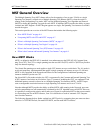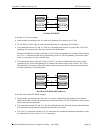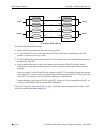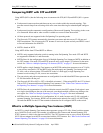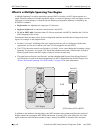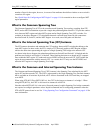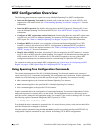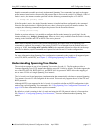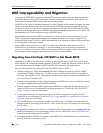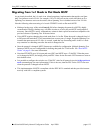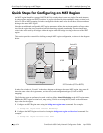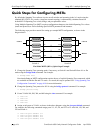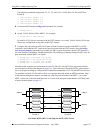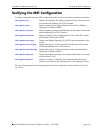
MST Interoperability and Migration Using 802.1s Multiple Spanning Tree
page 6-12 OmniSwitch 6600 Family Network Configuration Guide April 2006
MST Interoperability and Migration
Connecting an MSTP (802.1s) switch to a non-MSTP flat mode switch is supported. Since the Common
and Internal Spanning Tree (CIST) controls the flat mode instance on both switches, STP or RSTP can
remain active on the non-MSTP switch within the network topology.
An MSTP switch is part of a Multiple Spanning Tree (MST) Region, which appears as a single, flat mode
instance to the non-MSTP switch. The port that connects the MSTP switch to the non-MSTP switch is
referred to as a boundary port. When a boundary port detects an STP (802.1D) or RSTP (802.1w) BPDU,
it responds with the appropriate protocol BPDU to provide interoperability between the two switches. This
interoperability also serves to indicate the edge of the MST region.
Interoperability between 802.1s MSTP switches and 1x1 mode switches is not recommended. The 1x1
mode is a proprietary implementation that creates a separate Spanning Tree instance for each VLAN
configured on the switch. The 802.1s MSTP implementation is in compliance with the IEEE standard and
is only supported on flat mode switches.
Tagged BPDU transmitted from a 1x1 switch are ignored by a flat mode switch, which can cause a
network loop to go undetected. Although it is not recommended, it may be necessary to temporarily
connect a 1x1 switch to a flat mode switch until migration to MSTP is complete. If this is the case, then
only configure a fixed, untagged connection between VLAN 1 on both switches.
Migrating from Flat Mode STP/RSTP to Flat Mode MSTP
Migrating an STP/RSTP flat mode switch to MSTP is relatively transparent. When STP or RSTP is the
active protocol, the Common and Internal Spanning Tree (CIST) controls the flat mode instance. If on the
same switch the protocol is changed to MSTP, the CIST still controls the flat mode instance.
Note the following when converting a flat mode STP/RSTP switch to MSTP:
• Making a backup copy of the switch boot.cfg file before changing the protocol to MSTP is highly
recommended. Having a backup copy will make it easier to revert to the non-MSTP configuration if
necessary. Once MSTP is active, commands are written in their explicit form and not compatible with
previous releases of Spanning Tree.
• When converting multiple switches, change the protocol to MSTP first on every switch before starting
to configure Multiple Spanning Tree Instances (MSTI).
• Once the protocol is changed, MSTP features are available for configuration. Multiple Spanning Tree
Instances (MSTI) are now configurable for defining data paths for VLAN traffic. See “How MSTP
Works” on page 6-4 for more information.
• Using explicit Spanning Tree commands to define the MSTP configuration is required. Implicit
commands are for configuring STP and RSTP. See “Using Spanning Tree Configuration Commands”
on page 6-10 for more information.
• STP and RSTP use a 16-bit port path cost (PPC) and MSTP uses a 32-bit PPC. When the protocol is
changed to MSTP, the bridge priority and PPC values for the flat mode CIST instance are reset to their
default values.
• It is possible to configure the switch to use 32-bit PPC value for all protocols (see the bridge path cost
mode command page for more information). If this is the case, then the PPC for the CIST is not reset
when the protocol is changed to/from MSTP.
• This implementation of MSTP is compliant with the IEEE 802.1s standard and thus provides intercon-
nectivity with 802.1s compliant systems.



